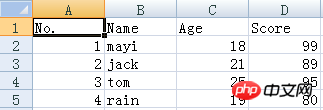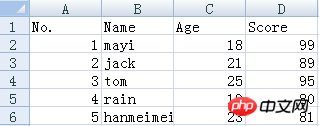 Backend Development
Backend Development
 Python Tutorial
Python Tutorial
 Example code sharing of how Python operates on Csv files (picture)
Example code sharing of how Python operates on Csv files (picture)
Example code sharing of how Python operates on Csv files (picture)
This article mainly introduces the example code of using Python to operate Csv files. It is very practical. Friends in need can refer to it.
csv is the abbreviation of Comma-Separated Values. It is table data stored in the form of a text file. For example, the following table:

can be stored as a csv file. The file content is:
No.,Name,Age,Score 1,mayi,18,99 2,jack,21,89 3,tom,25,95 4,rain,19,80
Assume that the above csv file is saved as "test.csv"
1. Read the file
How to use Python to extract one of the columns like operating Excel, that is A field can be implemented using the csv module that comes with Python:
The first method uses the reader function to receive an iterable object (such as a csv file), can return a generator, from which the content of the csv can be parsed: For example, the following code can read the entire content of the csv, in rows of units:
#!/usr/bin/python3
# -*- conding:utf-8 -*-
author = 'mayi'
import csv
#读
with open("test.csv", "r", encoding = "utf-8") as f:
reader = csv.reader(f)
rows = [row for row in reader]
print(rows)Get:
[['No.', 'Name', 'Age', 'Score'], ['1', 'mayi', '18', '99'], ['2', 'jack', '21', '89'], ['3', 'tom', '25', '95'], ['4', 'rain', '19', '80']]
To extract one of the columns, you can use the following code:
#!/usr/bin/python3
# -*- conding:utf-8 -*-
author = 'mayi'
import csv
#读取第二列的内容
with open("test.csv", "r", encoding = "utf-8") as f:
reader = csv.reader(f)
column = [row[1] for row in reader]
print(column)Get:
['Name', 'mayi', 'jack', 'tom', 'rain']
Pay attention to the values read from csv All are of str type. This method requires knowing the sequence number of the column in advance, for example, Name is in column 2, and you cannot query based on the title 'Name'. At this time, you can use the second method:
The second method is to use DictReader, which is similar to the reader function. It receives an iterable object and can return a generator, but each returned cell is placed Within the value of a dictionary, and the key of this dictionary is the title (i.e. column header) of this cell. You can see the structure of DictReader with the following code:# -*- conding:utf-8 -*-
author = 'mayi'
import csv
#读
with open("test.csv", "r", encoding = "utf-8") as f:
reader = csv.DictReader(f)
column = [row for row in reader]
print(column)[{'No.': '1', 'Age': '18', 'Score': '99', 'Name': 'mayi'},
{'No.': '2', 'Age': '21', 'Score': '89', 'Name': 'jack'},
{'No.': '3', 'Age': '25', 'Score': '95', 'Name': 'tom'},
{'No.': '4', 'Age': '19', 'Score': '80', 'Name': 'rain'}]
#!/usr/bin/python3
# -*- conding:utf-8 -*-
author = 'mayi'
import csv
#读取Name列的内容
with open("test.csv", "r", encoding = "utf-8") as f:
reader = csv.DictReader(f)
column = [row['Name'] for row in reader]
print(column)['mayi', 'jack', 'tom', 'rain']
2. Write file
When reading the file, we read the csv file into the list, and when writing the file, we will Elements are written to a csv file.#!/usr/bin/python3
# -*- conding:utf-8 -*-
author = 'mayi'
import csv
#写:追加
row = ['5', 'hanmeimei', '23', '81']
out = open("test.csv", "a", newline = "")
csv_writer = csv.writer(out, dialect = "excel")
csv_writer.writerow(row)
The above is the detailed content of Example code sharing of how Python operates on Csv files (picture). For more information, please follow other related articles on the PHP Chinese website!

Hot AI Tools

Undresser.AI Undress
AI-powered app for creating realistic nude photos

AI Clothes Remover
Online AI tool for removing clothes from photos.

Undress AI Tool
Undress images for free

Clothoff.io
AI clothes remover

Video Face Swap
Swap faces in any video effortlessly with our completely free AI face swap tool!

Hot Article

Hot Tools

Notepad++7.3.1
Easy-to-use and free code editor

SublimeText3 Chinese version
Chinese version, very easy to use

Zend Studio 13.0.1
Powerful PHP integrated development environment

Dreamweaver CS6
Visual web development tools

SublimeText3 Mac version
God-level code editing software (SublimeText3)

Hot Topics
 PHP and Python: Different Paradigms Explained
Apr 18, 2025 am 12:26 AM
PHP and Python: Different Paradigms Explained
Apr 18, 2025 am 12:26 AM
PHP is mainly procedural programming, but also supports object-oriented programming (OOP); Python supports a variety of paradigms, including OOP, functional and procedural programming. PHP is suitable for web development, and Python is suitable for a variety of applications such as data analysis and machine learning.
 Choosing Between PHP and Python: A Guide
Apr 18, 2025 am 12:24 AM
Choosing Between PHP and Python: A Guide
Apr 18, 2025 am 12:24 AM
PHP is suitable for web development and rapid prototyping, and Python is suitable for data science and machine learning. 1.PHP is used for dynamic web development, with simple syntax and suitable for rapid development. 2. Python has concise syntax, is suitable for multiple fields, and has a strong library ecosystem.
 Python vs. JavaScript: The Learning Curve and Ease of Use
Apr 16, 2025 am 12:12 AM
Python vs. JavaScript: The Learning Curve and Ease of Use
Apr 16, 2025 am 12:12 AM
Python is more suitable for beginners, with a smooth learning curve and concise syntax; JavaScript is suitable for front-end development, with a steep learning curve and flexible syntax. 1. Python syntax is intuitive and suitable for data science and back-end development. 2. JavaScript is flexible and widely used in front-end and server-side programming.
 PHP and Python: A Deep Dive into Their History
Apr 18, 2025 am 12:25 AM
PHP and Python: A Deep Dive into Their History
Apr 18, 2025 am 12:25 AM
PHP originated in 1994 and was developed by RasmusLerdorf. It was originally used to track website visitors and gradually evolved into a server-side scripting language and was widely used in web development. Python was developed by Guidovan Rossum in the late 1980s and was first released in 1991. It emphasizes code readability and simplicity, and is suitable for scientific computing, data analysis and other fields.
 Can vs code run in Windows 8
Apr 15, 2025 pm 07:24 PM
Can vs code run in Windows 8
Apr 15, 2025 pm 07:24 PM
VS Code can run on Windows 8, but the experience may not be great. First make sure the system has been updated to the latest patch, then download the VS Code installation package that matches the system architecture and install it as prompted. After installation, be aware that some extensions may be incompatible with Windows 8 and need to look for alternative extensions or use newer Windows systems in a virtual machine. Install the necessary extensions to check whether they work properly. Although VS Code is feasible on Windows 8, it is recommended to upgrade to a newer Windows system for a better development experience and security.
 Can visual studio code be used in python
Apr 15, 2025 pm 08:18 PM
Can visual studio code be used in python
Apr 15, 2025 pm 08:18 PM
VS Code can be used to write Python and provides many features that make it an ideal tool for developing Python applications. It allows users to: install Python extensions to get functions such as code completion, syntax highlighting, and debugging. Use the debugger to track code step by step, find and fix errors. Integrate Git for version control. Use code formatting tools to maintain code consistency. Use the Linting tool to spot potential problems ahead of time.
 How to run python with notepad
Apr 16, 2025 pm 07:33 PM
How to run python with notepad
Apr 16, 2025 pm 07:33 PM
Running Python code in Notepad requires the Python executable and NppExec plug-in to be installed. After installing Python and adding PATH to it, configure the command "python" and the parameter "{CURRENT_DIRECTORY}{FILE_NAME}" in the NppExec plug-in to run Python code in Notepad through the shortcut key "F6".
 Is the vscode extension malicious?
Apr 15, 2025 pm 07:57 PM
Is the vscode extension malicious?
Apr 15, 2025 pm 07:57 PM
VS Code extensions pose malicious risks, such as hiding malicious code, exploiting vulnerabilities, and masturbating as legitimate extensions. Methods to identify malicious extensions include: checking publishers, reading comments, checking code, and installing with caution. Security measures also include: security awareness, good habits, regular updates and antivirus software.





